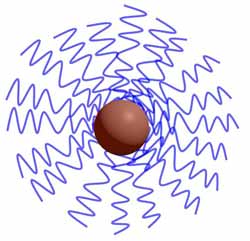'Premium Vectors' for the Life Sciences: Magnetic Nanoparticles

Schematic presentation of the new magnetic vectors: PDMAEMA arms attached to a crystalline iron oxide core stretch in all directions. The nanoparticle thus assumes a star-shaped appearance. The abbreviation "PDMAEMA" stands for "poly(2-(dimethylamino)ethylmethacrylat)".<br><br>Image: Department of Process Biotechnology, University of Bayreuth; free for publication when references are included.<br>
They show extremely high gene transfer efficiency and afterwards enable the quick and simple separation of the transfected cells from the transfection pool. A research team from the University of Bayreuth reports this result in the current online edition of “Biomacromolecules”.
Only five months ago a research team from the University of Bayreuth reported a discovery that was internationally acknowledged. The scientists led by Prof. Dr. Ruth Freitag (Process Biotechnology) and Prof. Dr. Axel Müller (Macromolecular Chemistry II) developed large star-shaped polymers that are promising vectors in genetic engineering. Most importantly, the new polymers were capable of introducing genes into a large variety of living cells, including non-dividing and differentiated cells, i.e. cells that up to now typically require viruses for efficient genetic modification. In chemical terms, these molecules can be described as PDMAEMA stars.
Now the Bayreuth team reports a related discovery in the current online edition of “Biomacromolecules”. As the team specifies, similar PDMAEMA stars can be constructed with a magnetic core and then combine the ability for efficient transfection with the potential for easy separation of the transfected from the non-transfected cells. This research success stems from an intensive interdisciplinary cooperation of long standing. The magnetic PDMAEMA stars were produced in the Bayreuth polymer chemistry laboratories. Tests in the Biotechnology group then demonstrated that the novel agents may very well constitute 'premium vectors' for the genetic modification of cells.
Biotechnological advantages: high transfection efficiency,
quick and simple isolation of transfected cells
Like the PDMAEMA stars previously tested, the magnetic PDMAEMA stars are also capable of efficiently introducing genetic information, i.e. DNA molecules, into living cells, a process called transfection. “When we transfected cells of a cell line originating from the Chinese hamster (CHO cells), we consistently observed transfection efficiencies that largely exceed those we previously obtained using poly(ethylenimine) (PEI)”, explains Prof. Dr. Ruth Freitag. Linear PEI has until now been regarded as the 'gold standard' in cell transfection and is therefore used in genetic engineering processes worldwide.
The new vectors have another advantage in addition to their unusual efficiency. The PDMAEMA stars retain their magnetic properties when they are within the cells. For this reason, the transfected cells can be separated from all other cells in a very simple manner: a standard strong magnet is sufficient to extract specifically the cells that have taken up the DNA from those that have not. This makes the magnetic PDMAEMA stars the ideal tool to extract successfully transfected cells from the general transfection pool, and thereby prepare in pure form, a genetically modified cell population, be it to introduce a new gene, compensate for a missing gene, to substitute a defect genes or to ameliorate the consequences of such aberrations.
Star-shaped giant molecules containing a magnetic core,
synthesis using modern polymer chemistry techniques
How are the magnetic PDMAEMA stars produced? Spherical nanoparticles are the starting point of this process. They belong to the class of iron oxides and have magnetic qualities. Initiator molecules are attached to the surface of such a particle, forming the starting points for the star-shaped structure. Each initiator starts the polymerisation of a long PDMAEMA chain, an 'arm'. This process (called “grafting from”) makes the spherical nanoparticle the centre of a large star-shaped molecule. When it is finished, the star-shaped molecule has on average 46 of these chain-like arms. Each arm contains nearly 600 repeating molecule groups.
Patent registration
On account of the high application potential for the life sciences, the magnetic PDMAEMA stars have been registered as a patent in the name of the University of Bayreuth by the Bavarian Patent Alliance (BayPAT, the central patent and marketing agency of the Bavarian universities). The Innovation Advisory Service of Bayreuth University, in particular Dr. Andreas Kokott und Dr. Heinz-Walter Ludwigs, made a major contribution to the preparation for the patent registration.
Publication:
Alexander P. Majewski, Anja Schallon, Valérie Jérôme, Ruth Freitag, Axel H. E. Müller, and Holger Schmalz,
Dual-Responsive Magnetic Core-Shell Nanoparticles for Non-Viral Gene Delivery and Cell Separation,
in: Biomacromolecules, Publication Date (Web): Feb 1, 2012
DOI: 10.1021/bm2017756
For suitability of PDMAEMA stars in genetic therapy see also:
http://www.uni-bayreuth.de/blick-in-die-forschung/31-2011.pdf
Contact for further information:
Prof. Dr. Ruth Freitag
Department of Process Biotechnology
University of Bayreuth
95440 Bayreuth, Germany
Tel.: +49 (0)921 55-7371
Email: ruth.freitag@uni-bayreuth.de
Prof. Dr. Axel Müller
Department of Macromolecular Chemistry II
University of Bayreuth
95440 Bayreuth, Germany
Tel.: +49 (0)921 55-3399
Email: axel.mueller@uni-bayreuth.de
Media Contact
More Information:
http://www.uni-bayreuth.deAll latest news from the category: Life Sciences and Chemistry
Articles and reports from the Life Sciences and chemistry area deal with applied and basic research into modern biology, chemistry and human medicine.
Valuable information can be found on a range of life sciences fields including bacteriology, biochemistry, bionics, bioinformatics, biophysics, biotechnology, genetics, geobotany, human biology, marine biology, microbiology, molecular biology, cellular biology, zoology, bioinorganic chemistry, microchemistry and environmental chemistry.
Newest articles

Silicon Carbide Innovation Alliance to drive industrial-scale semiconductor work
Known for its ability to withstand extreme environments and high voltages, silicon carbide (SiC) is a semiconducting material made up of silicon and carbon atoms arranged into crystals that is…

New SPECT/CT technique shows impressive biomarker identification
…offers increased access for prostate cancer patients. A novel SPECT/CT acquisition method can accurately detect radiopharmaceutical biodistribution in a convenient manner for prostate cancer patients, opening the door for more…

How 3D printers can give robots a soft touch
Soft skin coverings and touch sensors have emerged as a promising feature for robots that are both safer and more intuitive for human interaction, but they are expensive and difficult…





















